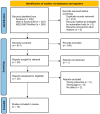Is There a Strength Deficit of the Quadriceps Femoris Muscle in Patients Treated Conservatively or Surgically after Primary or Recurrent Patellar Dislocations? A Systematic Review and Meta-Analysis
- PMID: 39274503
- PMCID: PMC11396229
- DOI: 10.3390/jcm13175288
Is There a Strength Deficit of the Quadriceps Femoris Muscle in Patients Treated Conservatively or Surgically after Primary or Recurrent Patellar Dislocations? A Systematic Review and Meta-Analysis
Abstract
Background: Patellar dislocation is a knee injury affecting generally young, active individuals, damaging joint ligaments and structures, and impacting sports activity and quality of life. Objective: This review aimed to evaluate the role of the quadriceps femoris muscle in knee extension and to consider whether extensor strength deficits are present in patients who have suffered from a primary or recurrent patellar dislocation and have been treated surgically or conservatively. Methods: This systematic literature review with meta-analysis was performed following the PRISMA Statement criteria. The search engines consulted to select studies were MEDLINE/PubMed, Scopus, and Web of Science/ISI. The JBI Critical Appraisal Checklist tools were applied for the quality assessment based on the specific study design. The outcomes were measurements of the knee extension force of the quadriceps femoris muscle, which were objectively quantifiable with an isokinetic or mobile dynamometer. Results: Of the 891 articles initially identified through the databases, 10 studies with a total of 370 patients were included in the analysis. The results indicated a strength deficit of the quadriceps in patients who had undergone a patellar dislocation, in comparison with the control group, when examining the uninvolved limb or in comparison with the pre-operative values. The overall effect size was large, with a value of -0.99. Conclusions: Our review concluded that after a primary or recurrent patellar dislocation, strength deficits of the quadriceps femoris muscle in the knee extension of the affected limb are frequently observed in surgically or conservatively treated patients. This deficit may persist even after a protracted follow-up of up to three years after injury.
Keywords: dynamometer; isokinetic; muscle strength; patellar dislocation; quadriceps femoris.
Conflict of interest statement
The authors declare no conflicts of interest.
Figures




Similar articles
-
Arthroscopic release of the vastus lateralis tendon for recurrent patellar dislocation.Am J Sports Med. 2006 May;34(5):824-31. doi: 10.1177/0363546505282617. Epub 2006 Jan 6. Am J Sports Med. 2006. PMID: 16399934
-
Bilateral Hidden Isokinetic Quadriceps Performance before and after MPFL Reconstruction in Pediatric Patients.J Knee Surg. 2021 Jul;34(8):906-912. doi: 10.1055/s-0039-3402031. Epub 2020 Jan 6. J Knee Surg. 2021. PMID: 31905414
-
Relationship of the knee extensor strength but not the quadriceps femoris muscularity with sprint performance in sprinters: a reexamination and extension.BMC Sports Sci Med Rehabil. 2021 Jun 10;13(1):67. doi: 10.1186/s13102-021-00293-1. BMC Sports Sci Med Rehabil. 2021. PMID: 34112228 Free PMC article.
-
Quadriceps Strength and Volitional Activation After Anterior Cruciate Ligament Reconstruction: A Systematic Review and Meta-analysis.Sports Health. 2019 Mar/Apr;11(2):163-179. doi: 10.1177/1941738118822739. Epub 2019 Jan 14. Sports Health. 2019. PMID: 30638441 Free PMC article.
-
Time, graft, sex, geographic location, and isokinetic speed influence the degree of quadriceps weakness after anterior cruciate ligament reconstruction: a systematic review and meta-analysis.Knee Surg Sports Traumatol Arthrosc. 2022 Oct;30(10):3367-3376. doi: 10.1007/s00167-022-06906-7. Epub 2022 Feb 27. Knee Surg Sports Traumatol Arthrosc. 2022. PMID: 35224649
Cited by
-
Recurrent patellar dislocation: treatments and challenges.Front Surg. 2025 Feb 5;12:1507362. doi: 10.3389/fsurg.2025.1507362. eCollection 2025. Front Surg. 2025. PMID: 39974514 Free PMC article. Review.
-
Pediatric Voluntary Habitual Hip Dislocation: Clinical Characteristics, Family Dynamics, and Long-Term Outcomes-A Retrospective Study.J Clin Med. 2025 Feb 6;14(3):1022. doi: 10.3390/jcm14031022. J Clin Med. 2025. PMID: 39941691 Free PMC article.
-
Frontier hotspots and development trends in research on sports injury prevention and treatment: A bibliometric and visualization analysis.Medicine (Baltimore). 2025 Aug 22;104(34):e44012. doi: 10.1097/MD.0000000000044012. Medicine (Baltimore). 2025. PMID: 40859528 Free PMC article.
-
Effects of kinesiology taping timing on recovery in the lower limbs.Front Physiol. 2025 Apr 28;16:1588339. doi: 10.3389/fphys.2025.1588339. eCollection 2025. Front Physiol. 2025. PMID: 40356767 Free PMC article.
References
-
- Slabaugh M.A., Hess D.J., Bajaj S., Farr J., Cole B.J. Management of Chondral Injuries Associated With Patellar Instability. Oper. Tech. Sports Med. 2010;18:115–122. doi: 10.1053/j.otsm.2009.12.003. - DOI
Publication types
LinkOut - more resources
Full Text Sources

